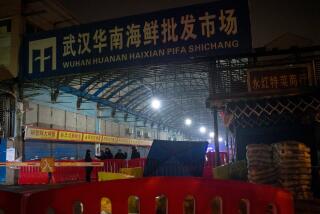Toronto Confirms 2 New SARS Cases; Report in India Questioned
- Share via
As an international SARS conference in Toronto concluded Thursday, Canadian officials reported two new cases of the pneumonia-like disease among health-care workers in the city -- a minor setback in efforts to control the outbreak.
Canadian health officials noted that there have been no new infections in Toronto outside of health-care workers, suggesting that efforts at containment are largely succeeding.
Meanwhile, a World Health Organization official in India said that 19 “confirmed” cases of severe acute respiratory syndrome had been identified in that country using an unreliable test, and that India may, in fact, be SARS-free. If so, that would be a relief to health authorities, who fear a major outbreak in countries such as India, which have high population densities and poor health-care systems.
In China, Beijing officials began moving victims of SARS into a hastily constructed hospital, while millions of people throughout the country stayed home for the May Day holiday in an effort to limit the disease’s spread.
As stringent efforts continued around the world to control the disease, Hong Kong officials reported some troubling new information, suggesting that people who have recovered from SARS can continue to spread the virus in feces and urine.
WHO reported a cumulative 5,865 SARS cases and 391 deaths as of Thursday. Those figures included 187 new cases in China and 11 in Hong Kong, the lowest daily increase in Hong Kong since early March. The United States has 52 probable SARS cases and no deaths.
The two new cases in Toronto brought the total number in the city to 264 and the number of deaths to 23. The patient with probable SARS is in a hospital in isolation, while the suspected case is being closely monitored.
“We believe that Canada is doing the right things, and they should have no further setbacks,” said Dr. David Heymann, the WHO spokesman for the conference.
Another WHO official, meanwhile, said the outbreak in Toronto might have been avoided if WHO had issued an alert about the disease sooner.
In an article prepared for a Canadian medical journal, Dr. Guenael Rodier, WHO’s director for communicable disease and response, said: “Had our international vigilance been in place prior to March 12, Toronto would very likely have been spared a SARS outbreak on the scale it has worked so admirably to contain.”
Rodier also cautioned that the economically crippling travel advisory imposed on Toronto last week by the health organization, then rescinded Tuesday, might make other countries less open about outbreaks of SARS or other infectious diseases.
India had reported Wednesday that the number of probable SARS cases there rose overnight to 19, bringing fears that a major outbreak might be in the offing. But Dr. S.J. Habayeb, the WHO representative in India, said Thursday that the tests used to confirm the cases “are not reliable.” Currently, 18 people remain hospitalized in India for observation and an additional 65 have been asked to remain isolated for 10 days.
Shortly before midnight Thursday in Beijing, four ambulances with police escorts brought the first groups of patients to a new SARS hospital that was hastily constructed next to an ostrich farm by a team of 7,000 workers. The patients were taken into the hospital by personnel wearing anti-infection suits, but reporters on the scene were unable to count the number of patients transferred. As they departed, the ambulances drove through disinfectant.
According to WHO, SARS has now infected more than 3,600 Chinese and killed 170 people since the outbreak began in Guangdong province late last year. “China now accounts for more probable cases than the rest of the world combined,” according to a WHO statement issued Thursday.
In an effort to control the spread, China cut its “Golden Week” holiday to a long weekend, and it issued stern warnings to discourage urban residents from heading home to more isolated provinces.
In Hong Kong, physicians said that 12 SARS patients who had suffered relapses two to three weeks after being discharged had all been treated at secondary hospitals, not at Prince of Wales Hospital, where the first cases were handled. Patients were sent to Princess Margaret Hospital and United Christian Hospital only when Prince of Wales began to be overwhelmed.
Dr. Margaret Chan, Hong Kong’s health director, said the latter two hospitals -- which had less experience treating SARS patients -- may have sent them home too soon.
Authorities are not yet certain whether patients suffering a relapse are capable of spreading the disease. If they are, it could represent a new source of infection, since most patients were warned to stay home only for two weeks after being discharged.
However, Dr. Brian Tomlinson of Prince of Wales Hospital said the relapses may simply represent a delayed and excessive immune reaction to the steroids and antiviral agents used to treat the patients. If that is the case, the relapsed patients probably do not present a risk to their contacts, he added.
However, Chan also said new tests show that some recovered patients continue to shed the coronavirus that causes SARS in their stools and urine for a week or more after their recovery. Tests are being done, she said, to see whether the virus remains infectious.
Authorities are worried about the possibility because excrement has previously been identified as a source of viral transmission. An outbreak in a Hong Kong apartment complex was traced to a leaking sewage line, and another outbreak in a hospital was similarly traced to a damaged sewer pipe over a patient treatment area.
Doctors at Prince of Wales also said Thursday that some patients who had apparently recovered from SARS showed signs of permanent lung damage, as also occurs with tuberculosis and other lung diseases.
Dr. Anil Ahuja said it is not clear whether the damage -- which is highly variable from patient to patient -- was caused by the viral infection or by the treatment, or whether patients will recover lost lung function.
“Only time will tell what the actual consequences will be,” he said.
U.S. and Canadian researchers on Thursday published the genetic blueprint of the SARS coronavirus.
The genetic sequence, published online by the journal Science, provided no surprises. The two virtually identical sequences -- one from a Toronto patient and one from a patient from Asia -- were announced last month to wide publicity. But scientists continue to be perplexed by the lack of similarity to any previously known coronavirus. Researchers had hoped that the sequence would provide clues to the virus’ origin.
More to Read
Sign up for Essential California
The most important California stories and recommendations in your inbox every morning.
You may occasionally receive promotional content from the Los Angeles Times.













